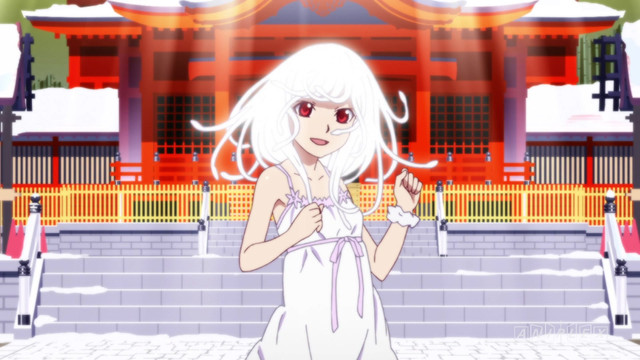
Monogatari is a light novel series written by the esteemed Nisio Isin. The series gained more fame through its excellent anime adaptation quickly becoming an example of studio Shaft’s talent. Borrowing techniques from the French New Wave, Monogatari utilizes jump cuts, objects to replace speakers, 4th wall breaks, and color to show emotional changes in backgrounds to supplement the show’s writing and dialogue.
Monogatari often calls attention to its source material and medium. This commonly appears in the form of 4th wall breaks and its cuts to monochromatic “display cards” that show text and chapters referenced. The importance of writing is critical to Monogatari’s story--the wordplay, topics of discussions, and the nuance of dialogue all have significant implications towards character growth and plot.
During the second season of Monogatari, the Nadeko Medusa arc uses one’s awareness of story structure and writing concepts. The unreliable narrator, the relativity of victim and perpetrator, the control of narration, calling attention to writing (as a craft), and other such concepts are woven into this arc. It is by controlling these ideas that Nadeko Sengoku gains power usurps her role as the main character.
Finding Identity
Monogatari likes to play with archetypes. Characters will have personality quirks and visual tropes adhering to their archetype. What’s special about Monogatari is that it pushes its archetypes that realistically make them act and be who they are. The show supports and later grows an archetype’s identity.
In the bigger picture, Nadeko Sengoku is a minor character, receiving one arc in season 1 and small appearances throughout the series. Her identity (or what she wishes she could be) overlaps with other characters. She cannot be the main character’s sister--he already has two--and he cannot be his girlfriend. After all, he loves his girlfriend, and they’re even described by his sister to be “a perfect match. To the point that she’s the only one for him.”
In the Medusa Arc, understanding identity is integral. One of the chief concerns of its protagonist is that she is unimportant. This is implied through her actions--she cannot/will not say this because speaking of her fear is acknowledging it. She becomes frantic when others impose an identity on her: class president, cute, perpetrator. Her staunch refusal sets the course of the story, one she needs to control. Without controlling the story, she cannot truly the protagonist, the most important character--others are in the way.
The Serpent’s Trick
Depending on your culture, the depiction of a snake can vary in its meaning. Snakes can be tricksters, icons of immortality, representations of sexuality, symbols of health and medicine, Gods, titans of power, and more. The connotation of a snake changes depending on where you are and the circumstance.
Some identities exist in conjunction with others. You cannot be a girlfriend if you do not have a partner. You cannot be class president with no class. You cannot be special if everyone else is too. The snake is a part of Nadeko, one she literally embodies after eating its talisman.
The great trick of the arc is we’re watching a lie, one told from the “serpent’s mouth.” The majority of the arc takes place during fabricated events. Nadeko weaves a story where she is at its center. Where she is the victim. Where she finally is important. Then she rejects and silences opposition towards that story either by ignoring inconveniences, repurposing it, or killing the people that say otherwise. In the final episode of the arc, this is particularly obvious, as she stabs both Araragi to preserve her idea of a tragic love and kills Shinobu who laughs that Nadeko is playing the “victim.”
There is just one problem…
The Unreliable Narrator and Snake Imagery
Identity is not solely insular.
There are some aspects of one’s identity that cannot be determined by yourself. It doesn’t matter that Nadeko controls the narrative. It doesn’t matter that she silences opposition. She cannot truly be what she claims without them. As much as she tries to suppress that she is conniving and a liar (like a snake)--she is telling a story while already Medusa.
External elements can influence oneself. In the arc, despite Nadeko’s intentions to seem innocent, she cannot help herself. This manifests itself visually. For example, in the second episode of the arc, establishing shots of the background are shown as she walks to school. We see the road and the fences from the side as they appear normally: straight. However, the camera shifts to the foreground, and as Nadeko walks, she walks towards us. From this perspective, we see both the road she sees, but also Nadeko’s face, and from this perspective we learn two things. First, that the road Nadeko walks is hardly straight, but curves like a winding road. Second, despite what we notice, Nadeko is oblivious. She looks at her feet, barely noticing the environment around her.
This type of contrast hints that reality isn’t exactly normal here, and more importantly, the reality Nadeko tells us isn’t exactly given to us straight. This winding imagery isn’t by coincidence. It appears elsewhere. When Nadeko wants to take a break at school, she goes to the top. To do so, she must climb two spiraling staircases that snake around each other. From afar, the staircases look like the caduceus, the rod of the Greek god Hermes (god of travel, trade, and roads amongst other things). Yet another example comes from Nadeko again. As she calls Araragi for help, her eyes constantly fixate on the bright green cord of the school phone. When she lies on the phone and later hangs up, snakes emerge from it.
Despite Nadeko’s wish to be unlike a snake, even in her story, they still emerge against her will. Even if she kills the characters in the story, as the audience, we see the story she crafts and the lie behind it.
Final Thoughts

Monogatari is a dense work, and the craftsmanship that goes into its directing and writing still impresses me. As I was writing this article, I kept thinking how much there was still left to say, but perhaps that better left for another piece. If you enjoyed this article or were intrigued by this story’s arc, feel free to leave a comment. I hope to write more about Monogatari in the future!
Recommended Post
6 Anime Like Kizumonogatari [Recommendations]
Recommended Post
6 Anime Like Bakemonogatari [Recommendations]
Recommended Post
6 Anime Like Owarimonogatari [Recommendations]
Recommended Post
6 Anime Like Kizumonogatari I: Tekketsu-hen (Kizumonogatari Part 1: Tekketsu)[Recommendations]
Recommended Post



